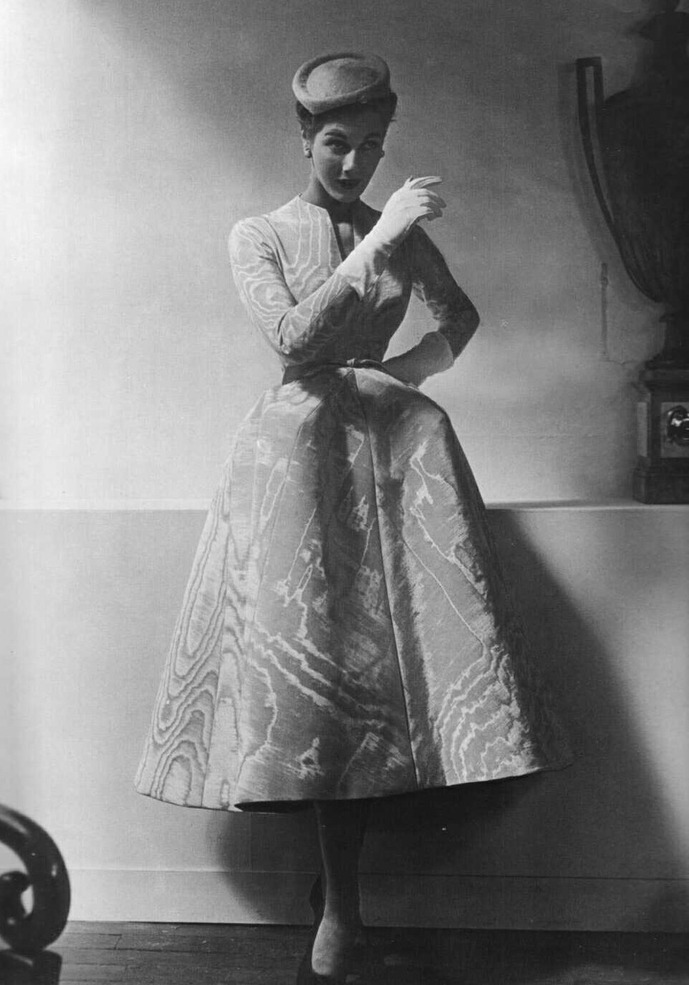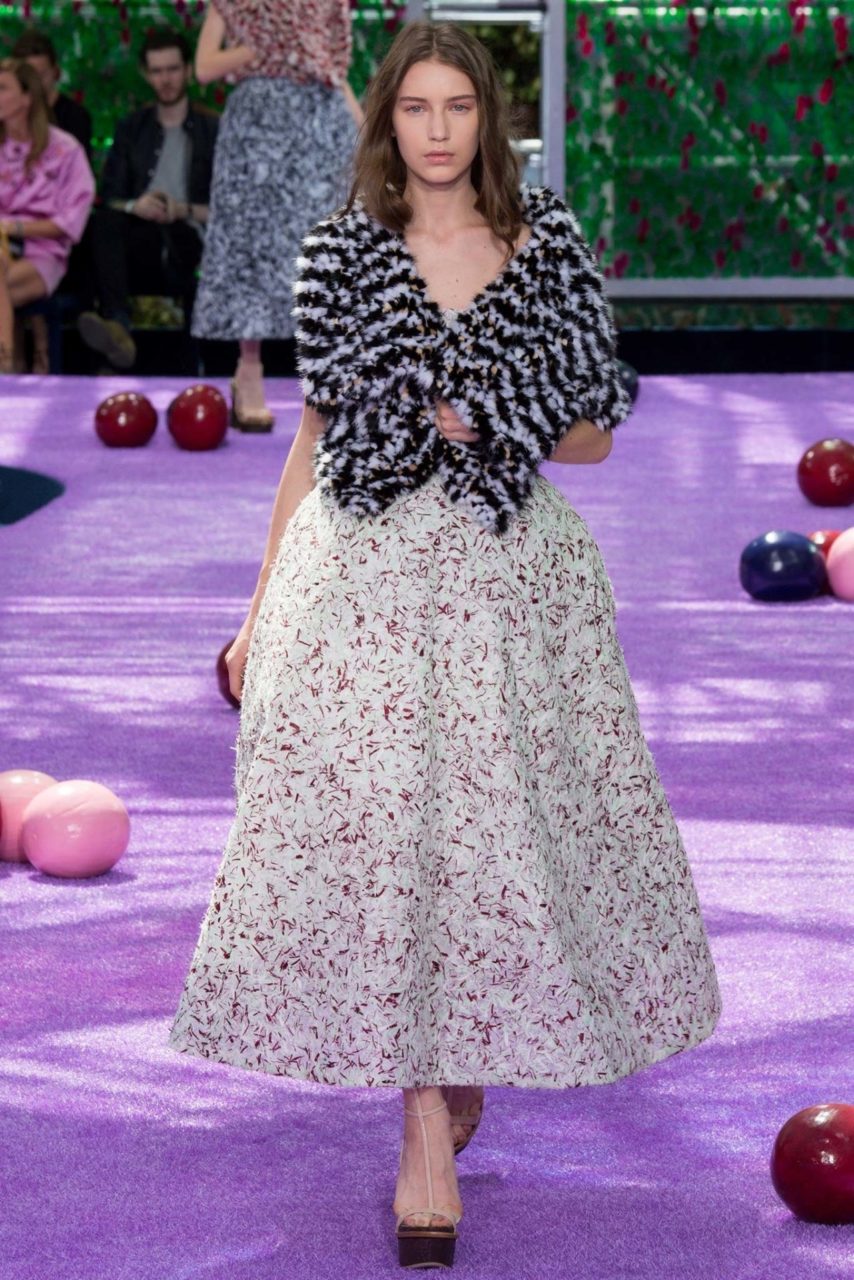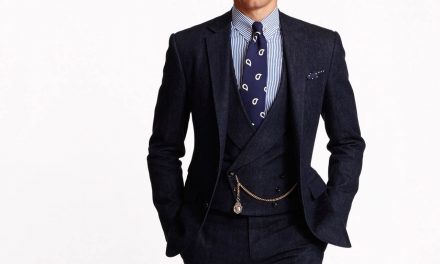La Cigale is a sharply structured gown by Christian Dior for his 1952 A/W collection Profile Line. This collection followed the lines of his New Look style and added contrasts in color and shape.
About the Look
L
a Cigale was designed by Christian Dior for the House of Dior and was presented to the public as part of his 1952 Fall/Winter collection “Profile Line” (Fig. 1), which featured a distinctive sharp silhouette. This example, possibly made for a department store, is made of a blend of cotton, rayon and acetate, and has an unknown understructure, but is almost certainly supported by a stiff petticoat. At the time, Town & Country labelled it a “day-length dinner dress” (139).
The dress–perhaps like the cicada it is named after–is rigidly structured, cinched tight at the waist and built out almost in points around the hips. The upper portion of the dress consists of long sleeves and round collar with a narrow and deep opening that stops around the level of the bust point. At the smallest part of the waist, a knot is tied in self-trim. The darts on the bust are Y-shaped, and the skirt has multiple unusual seams. As the Metropolitan Museum of Art explains:
“the dress becomes the housing of the fashionable posture now required by its apparent weight: the skirt is cantilevered at the hipbone—hip forward, stomach in, shoulders down, and the back long and rounded. Dior employed shaped pattern pieces to mold the bodice to the body and likewise to allow for the dilation at the hips.”
As seen in figure 2, “La Cigale” features moiré fabric, which can be likened to shimmering fiber lines in a plank of wood. The fabric is gray, but depending on the light can take on a beige or purple tone. The original gown was designed in gray moiré ribbed silk ottoman, a very heavy fabric perfect for this structured design.
Fig. 1 - Christian Dior (French, 1905-1957). "La Cigale" in Vogue (New York), Vol. 120, Iss. 4, (Sep 1, 1952). Photographed by Frances Mclaughlin-Gill. Source: ProQuest
Fig. 2 - Christian Dior (French, 1905-1957). La Cigale Waist, Fall/Winter 1952. Blend of cotton, rayon and acetate. C.I.59.26.3a, b. Source: MMA
Christian Dior (French, 1905-1957). La Cigale, Autumn/Winter 1952. Blend of cotton, rayon and acetate. New York: Metropolitan Museum of Art, C.I.59.26.3a, b. Gift of Irene Stone, in memory of her daughter, Mrs. Ethel S. Greene, 1959. Source: MMA
About the context
It is important to note that only a few years prior to “La Cigale,” Christian Dior popularized one of the most revolutionary (some might say regressive) trends in modern fashion history–the so-called New Look. During World War II (1939-45), the fashion industry had made sacrifices to support the war effort, limiting yardage and fabric selection. In early 1947, Dior presented his New Look–a cinched-in, often boned, silhouette paired with ample skirt volume (Fig. 3)–to France. The decade that followed was considered the ‘golden age’ of couture by Dior himself, and he sent an array of new silhouettes down the runway each season. During this time, Dior drew inspiration from flowers and the feminine shape–a definitive break with the stream-lined and utilitarian war styles. In Dior: The New Look Revolution (2015), Laurence Benaïm states that “for Christian Dior, a well-defined waist indicated youth” (89).
“La Cigale” embraces the same feminine silhouettes of the New Look–protruding breasts and hips, a cinched waist, small shoulders, and a large, long skirt–that Dior established five years earlier. In The History of Modern Fashion from 1850 (2015), Daniel James Cole and Nancy Diehl explain that there were two consistent silhouettes throughout the 1950s. One was a narrow skirt fitted to the hips, and the other “featured a full skirt created by either gores or gathers and a fitted bodice” (235). Vogue in 1952 agreed, writing “Slim skirt of full skirt, every Dior dress has a figure that’s emphatically defined” (Daves 165). As seen in figure 1, the skirt of “La Cigale” is the latter style; the rigid structure creates a very full skirt and outlines the exaggerated feminine silhouette key to the New Look.
“La Cigale” was well-received by critics upon its debut. Vogue editor Jessica Daves called “La Cigale”: “the Queen of Hearts skirt” in her September 1952 “Paris Collections” report (165) and described “La Cigale” (Fig. 1) in particular as:
“a masterpiece of construction and execution, the new, full, formed Dior skirt, falling away from a stiff yoke and a superbly moulded bodice. ‘La Cigale’–in pearl-grey ottoman moire, for late day.” (165)
In Harper’s Bazaar (Fig. 6), Carmel Snow described “La Cigale” as constructed of “gray moiré, so heavy it looks like a pliant metal,” (Snow 210). In their introduction of the ensemble the same month, Town and Country magazine points out “the panniered hips in the manner of a Velázquez infanta, the sculptured bodice, the slit of the neckline” (139). The author was referring to the series of portraits of Spanish princesses done by Diego Velázquez in the seventeenth century. As seen in the 1659 painting in figure 4, the gowns that were in style for the Spanish court at this time feature extremely wide skirts with extended hips that were supported by a boned understructure similar in spirit to “La Cigale.”
All Dior gowns had similar understructures during this time – built-in corsetry and boned and stuffed underskirts. Dior used similar techniques for the waist on the gown on the right in figure 5, which was named “Passacaille” and also utilized moiré silk.
In Mystique and Identity: Women’s Fashions of the 1950s (1984), Barbara Schreier discusses the hidden structures of couture dresses:
“[Dior] devised special boned corsets to cinch in the waist and push up the breasts, and his skirts were shaped with padding, pleats, and stiffened linings. A woman had only to step into a Dior gown; the interior scaffolding did the rest.” (10)
Among positive press, there was some outrage due to the amount of material needed to make dresses like “La Cigale.” This stemmed from World War II restrictions, as cloth had been heavily rationed and large skirts were still seen as a luxury in the early fifties.
Iconic photographers of the time like Richard Avedon captured Dior’s pieces in ways that matched the garments’ elegance and beauty (Fig. 6). While Dior designs were considered haute couture, this particular dress was also licensed to be sold at department stores in America: Henri Bendel, Kaufmann’s, I. Magnin, and Marshall Field’s, amongst others (Snow 210). One of the silk moiré couture examples, complete with Dior bolduc (a white tape label with a unique number), is retained in the collection of the Kyoto Costume Institute (Fig. 7).
Fig. 3 - Christian Dior (French, 1905-1957). New Look (coat), 1947-48. Silk; circumference: 96 cm bust. London: Victoria and Albert Museum, T.197-1997. Given by Mrs J. Wates. Source: VAM
Fig. 4 - Diego Rodriguez de Silva y Velázquez (Spanish, 1599-1660). Infanta Margarita Teresa (1651-1673) in a blue dress, 1659. Oil on canvas; 125.5 × 106 cm. Vienna: Kunsthistorisches Museum, Gemäldegalerie, 2130. Source: KMW
Fig. 5 - Christian Dior (French, 1905-1957). Passacaille shown on right, Photographed by Ronny Jaques for Town and Country, Vol. 106, Iss. 4360 (September 1952). Source: ProQuest
Fig. 6 - Christian Dior (French, 1905-1957). La Cigale, Photographed by Richard Avedon for Harper's Bazaar, Vol. 85, Iss. 2890, (September 1952): 211. Source: ProQuest
Fig. 7 - Christian Dior (French, 1905-1957). Day dress "La Cigale", Autumn/Winter 1952. Grey silk ottoman moiré; hard double tulle petticoat.. Kyoto Costume Institute, AC391 77-13-8AC. Source: KCI
Its Afterlife
Dior’s legacy lives on through many designers today. In figure 8, the silhouette of “La Cigale” is echoed in a look created by Raf Simons for Dior’s Fall/Winter 2015 collection. The skirt extends outward from the hips in an unnatural slope, much like the “La Cigale.” Simons paired the dress with a fur wrap, which is similar to the accessory styling of Dior in the 1950s (Fig. 6).
Fig. 8 - Raf Simons for Dior (Belgian, 1968-present). Look 27, Fall/Winter Haute Couture 2015. Source: Vogue
References:
- Benaim, Laurence. Dior: The New Look Revolution. New York: Rizzoli, 2015. Worldcat
- “La Cigale.” Metropolitan Museum of Art. MMA
- Cole, Daniel James, and Nancy Deihl. The History of Modern Fashion From 1850. London: Laurence King Publishing, 2015. Worldcat
- “Collection Items–Paris.” Town & Country 106, no. 4360 (September 1952): 136-141, 178. ProQuest
- Daves, Jessica, ed. “Paris Collections: Complete Report: News in Two New Forms.” Vogue 120, no. 4 (September 1, 1952): 150-220. The Vogue Archive. ProQuest
- Schreier, Barbara. Mystique and Identity: Women’s Fashions of The 1950s. Norfolk, VA: Chrysler Museum, 1984. Worldcat
- Snow, Carmel.“Carmel Snow Reports from Paris: Carmel Snow’s Report.” Harper’s Bazaar 85, no. 2890 (September 1952): 209-211. The Harper’s Bazaar Archive. ProQuest



















